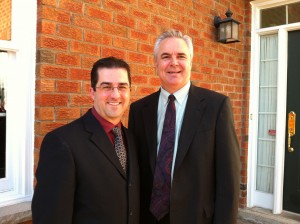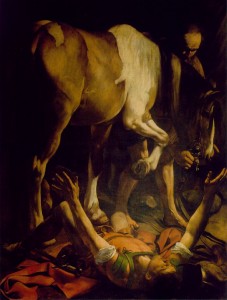 I’m now booking more seminars for the U.S., Canada, and overseas explaining the new Mass translation. Or, you can choose one of the many other topics available. Simply use the “Contact” page here to send us a message and get the process started. Our calendar is filling up quickly, so book now to avoid disappointment. End of infomercial!
I’m now booking more seminars for the U.S., Canada, and overseas explaining the new Mass translation. Or, you can choose one of the many other topics available. Simply use the “Contact” page here to send us a message and get the process started. Our calendar is filling up quickly, so book now to avoid disappointment. End of infomercial!
Archive for month: July, 2011
 Tonight I’ll be appearing on “The Journey Home” program on EWTN with Marcus Grodi. Marcus interviewed me recently about my journey from nominal Catholicism to agnosticism, to Protestant ministry, and eventually home to the Catholic Church. You can watch it at 8 PM, or catch it in live streaming format on EWTN’s website. It will re-air on Tuesday, July 19, at 1 AM & 9 AM, Thursday, July 21 at 2 PM, and Saturday, July 23, at 11 PM (all times Eastern). The entire weekly EWTN schedule can be found here.
Tonight I’ll be appearing on “The Journey Home” program on EWTN with Marcus Grodi. Marcus interviewed me recently about my journey from nominal Catholicism to agnosticism, to Protestant ministry, and eventually home to the Catholic Church. You can watch it at 8 PM, or catch it in live streaming format on EWTN’s website. It will re-air on Tuesday, July 19, at 1 AM & 9 AM, Thursday, July 21 at 2 PM, and Saturday, July 23, at 11 PM (all times Eastern). The entire weekly EWTN schedule can be found here.
I also had a chance to guest on the “Deep in Scripture” radio program, also hosted by Marcus, which will air this Wednesday at 2 PM on EWTN radio, and at this link: We had a great time exploring John 21 and the implications of that text for the Papacy.
This week, I guess it’s all EWTN, all the time!
 An empty tomb alone does not a resurrection make, and that’s why the appearances of the risen Jesus are so important. With Christ’s resurrection, as with the truth of Catholicism in general, what we have is a series of converging and convincing arguments that are the most plausible explanation of the facts that we have. So, let’s take a deeper look at the evidence that Jesus appeared alive in bodily form to many after his death and burial.
An empty tomb alone does not a resurrection make, and that’s why the appearances of the risen Jesus are so important. With Christ’s resurrection, as with the truth of Catholicism in general, what we have is a series of converging and convincing arguments that are the most plausible explanation of the facts that we have. So, let’s take a deeper look at the evidence that Jesus appeared alive in bodily form to many after his death and burial.
My former professor and resurrection expert, Dr. Gary Habermas, lists ten considerations in favor of Jesus’ resurrection appearances. These ten points have two things in common: they are attested by scholars, both Christian and skeptic alike; and natural phenomenon alone fail to explain all of the data. Today, let’s look at those facts that have to do with the appearance to St. Paul. It’s good to start with him, because Paul’s conversion was a key event in the spread of the early Church. The question is, what caused Paul to convert, and what caused his preaching to be so successful? The best explanation is the bodily resurrection of Jesus. Here’s why:
1. No scholar seriously doubts the historical fact of St. Paul’s conversion. The facts are: that he was a Pharisee who violently opposed the nascent Church, and that he subsequently became not only a believer in Jesus, but the greatest missionary of all time – and these facts are not in doubt. Paul himself stated that the reason he became a Christian was because the risen and glorified Christ appeared to him (1 Cor. 9:1, 15:8; Gal. 1:16). The man’s own opinion of the matter counts! Just about every New Testament scholar maintains that Paul wrote most, if not all of the NT letters attributed to him, so the biographical details he provided are firsthand testimony that Paul believed he encountered the risen Lord. At any rate, something has to explain Paul’s radical change from persecutor to propagator of the new faith -and the best explanation is the resurrection.
2. In 1 Corinthians 15:3 and following, Paul quotes what is universally acknowledged as an early Church “creed” – a formula that predates Paul’s letter, likely by two decades. The composition of this creed that focuses on Christ’s death, burial and resurrection appearances thus dates to within mere months of the event of the Jesus’ resurrection. This makes it extremely unlikely that it is a legendary account, embellished over time. The presence of living witnesses to the events themselves also mitigates against that thesis. Paul himself notes (1 Cor. 15:6) that on one occasion, Jesus appeared to more than 500 people at once, most of whom were still alive and ostensibly willing to be interviewed about the facts. Habermas notes that most scholars believe that Paul received this creed abut AD 35, from the apostles Peter and James (see Gal. 1:18-19). Habermas also confirms that Paul’s choice of words in this passage, such as the Greek word historeo, indicates that he systematically interviewed, if you will, the apostles about the events behind this creed.
3. Paul was so concerned that he was preaching an historically accurate message that he returned to Jerusalem 14 years later – to once again submit his message to the other apostles for examination (Gal. 2:1-10)! He was extremely concerned about the accuracy of his statements. This time, Paul specifically mentions John’s presence – thus confirming that all three apostles who were part of Jesus’ “inner circle”, the men who knew our Lord best while he was on earth, ratified Paul’s message once again.
4. Not only did the other apostles confirm Paul’s take on the gospel, Paul in turn confirms theirs: he verifies that he knew what the other apostles were preaching (1 Cor. 15:11), and that all of them were preaching the same message of Jesus’ resurrection with one voice. In light of all this, the oft-repeated idea that some revisionist scholars have that Paul, not Jesus, was the “inventor” of Christianity is obviously untenable.
Paul’s testimony to the appearances of the risen Christ are crucial to the overall argument. But there’s far more to be explored. In the next installment of this series, we’ll consider six more facts that Habermas puts forth to buttress the case for the resurrection appearances of Jesus Christ.
The patriarch Joseph, the son of Jacob, is in many ways a type of Joseph, the foster father of Jesus and the patron of the universal Church. The Mass readings from Genesis over the last couple of days call to mind parallels between the two Josephs. In his magnificent daily devotional series, In Conversation with God, Fr. Francis Fernandez notes some of the most striking similarities, summarized below:
1. Both Josephs were forced to go to Egypt – the patriarch was sold into slavery by his brothers (prefiguring the handing over of Jesus by his kinsmen), while the husband of Mary was forced there to avoid the wrath of Herod, who sought the infant Jesus’ life (cf. Matt. 2:13-15).
2. God enabled the OT Joseph to interpret the dreams of Pharaoh; God spoke to the NT Joseph through dreams. In a sense, a particular dream of the first Joseph would be fulfilled in a greater way by the second: “…and behold, the sun, the moon, and eleven stars were bowing down to me” (see Genesis 37:5-10). Joseph meant by this his parents and brothers. Later, the Sun of Righteousness, Jesus Christ, and his Mother Mary, (the Christian who best reflected God’s glory, as the moon best reflects the sun), would, in a sense, “bow” to Joseph by submitting to his leadership in the holy house of Nazareth.
3. Joseph the patriarch won the favour of the most powerful king on earth, so much so that when hungry nations came to Egypt looking for food, Pharaoh could say confidently, “Go to Joseph, and what he says to you, do” (Gen. 41:55). Today, the world is hungry for spiritual food – true Christian teaching, because “man does not live by bread alone, but by every word that proceeds from the mouth of God” (Matt. 4:4). We, too, must “go to Joseph”, for he, like Mary, will lead us to the Lord they know better than anyone ever did. And Joseph protects the members of Christ ‘s mystical body just as surely as he cared for Jesus himself.
Truly we can see here that, as Scott Hahn puts it, “God writes the world the way humans write with words”. Just as a human author used devices like foreshadowing to make a point, God uses historical events and people of the Old Covenant – like the patriarch Joseph – to preview far the far greater personages and events of the New.


